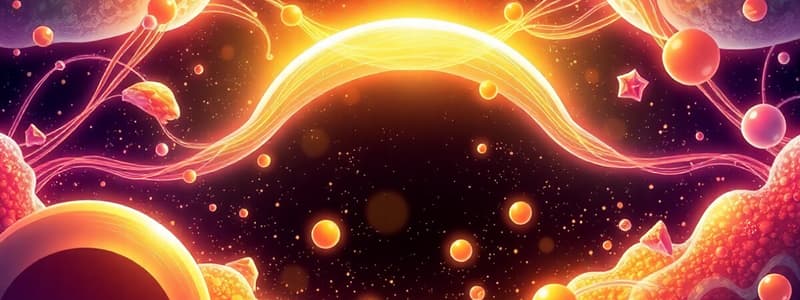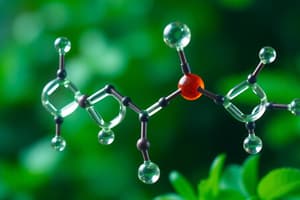Podcast
Questions and Answers
What are proteins primarily composed of?
What are proteins primarily composed of?
- Carbon, hydrogen, oxygen, nitrogen, and sometimes sulfur (correct)
- Carbon, nitrogen, oxygen, phosphorus, and sulfur
- Nitrogen, carbon, hydrogen, calcium, and oxygen
- Hydrogen, nitrogen, oxygen, magnesium, and carbon
What determines the identity of an amino acid?
What determines the identity of an amino acid?
- The carboxyl group
- The amino group
- The peptide bond
- The side group (correct)
Which of the following is NOT a function of proteins?
Which of the following is NOT a function of proteins?
- Transport
- Movement
- Biochemical control
- Energy storage (correct)
What type of bond is formed between amino acids?
What type of bond is formed between amino acids?
What process involves building larger molecules by removing water?
What process involves building larger molecules by removing water?
Which protein is primarily involved in muscle movement?
Which protein is primarily involved in muscle movement?
What is the basic unit that makes up proteins?
What is the basic unit that makes up proteins?
Which nucleic acid is associated with protein synthesis?
Which nucleic acid is associated with protein synthesis?
What type of molecule are enzymes classified as?
What type of molecule are enzymes classified as?
How many amino acids are universally used by organisms to form proteins?
How many amino acids are universally used by organisms to form proteins?
What is a characteristic feature of carbohydrates?
What is a characteristic feature of carbohydrates?
What type of carbohydrate is formed by two covalently bonded monosaccharides?
What type of carbohydrate is formed by two covalently bonded monosaccharides?
Which statement about lipids is true?
Which statement about lipids is true?
What is a primary function of fats in living organisms?
What is a primary function of fats in living organisms?
What distinguishes saturated fats from unsaturated fats?
What distinguishes saturated fats from unsaturated fats?
What are phospholipids primarily associated with in living organisms?
What are phospholipids primarily associated with in living organisms?
Which carbohydrate is classified as a polysaccharide?
Which carbohydrate is classified as a polysaccharide?
Which of the following statements about steroids is true?
Which of the following statements about steroids is true?
What role do simple sugars, known as monosaccharides, play in living organisms?
What role do simple sugars, known as monosaccharides, play in living organisms?
Which organic compound serves as a type of structural support in plants?
Which organic compound serves as a type of structural support in plants?
What is the primary role of hemoglobin in the body?
What is the primary role of hemoglobin in the body?
Which protein is primarily involved in structural functions within connective tissue?
Which protein is primarily involved in structural functions within connective tissue?
What type of bond links amino acids together in a protein?
What type of bond links amino acids together in a protein?
Which of the following processes involves breaking down molecules by adding water?
Which of the following processes involves breaking down molecules by adding water?
What distinguishes the 20 different amino acids used by organisms?
What distinguishes the 20 different amino acids used by organisms?
What is a common characteristic of polymers formed from monomers?
What is a common characteristic of polymers formed from monomers?
Which function of proteins is essential for muscle contraction?
Which function of proteins is essential for muscle contraction?
Which type of nucleic acid is primarily involved in the direct synthesis of proteins?
Which type of nucleic acid is primarily involved in the direct synthesis of proteins?
What is the primary role of enzymes in biochemical reactions?
What is the primary role of enzymes in biochemical reactions?
How many covalent bonds can a carbon atom form due to its electron configuration?
How many covalent bonds can a carbon atom form due to its electron configuration?
What is the primary reason carbon is prevalent in organic compounds?
What is the primary reason carbon is prevalent in organic compounds?
Which statement accurately describes monosaccharides?
Which statement accurately describes monosaccharides?
What distinguishes saturated fats from unsaturated fats?
What distinguishes saturated fats from unsaturated fats?
Which of the following best describes polysaccharides?
Which of the following best describes polysaccharides?
Which function is NOT associated with the role of lipids in living organisms?
Which function is NOT associated with the role of lipids in living organisms?
Which type of carbohydrate serves as an energy source for organisms?
Which type of carbohydrate serves as an energy source for organisms?
What is the role of phospholipids in biological systems?
What is the role of phospholipids in biological systems?
Which of the following describes the structure of steroids?
Which of the following describes the structure of steroids?
What type of molecule are fats mainly composed of?
What type of molecule are fats mainly composed of?
Which of the following is NOT a characteristic of carbohydrates?
Which of the following is NOT a characteristic of carbohydrates?
Flashcards
Proteins
Proteins
Organic molecules made of carbon, hydrogen, oxygen, nitrogen, and sometimes sulfur. They are essential for life and form structures like muscles, hair, and skin.
Amino Acids
Amino Acids
The building blocks of proteins. Each has an amino group (-NH2), a carboxyl group (-COOH), and a unique side group.
Peptide Bond
Peptide Bond
The covalent bond that connects amino acids together in a protein chain.
Protein Functions
Protein Functions
Proteins have many jobs in the body, like movement (actin/myosin), structure (collagen), chemical reactions (enzymes), carrying things (hemoglobin), storing things (casein), controlling things (hormones), and defense (antibodies).
Signup and view all the flashcards
Monomers
Monomers
Small molecules that can combine to form larger molecules (polymers).
Signup and view all the flashcards
Polymers
Polymers
Large molecules made of repeating monomer units bonded together.
Signup and view all the flashcards
Dehydration Synthesis
Dehydration Synthesis
The process of linking monomers by removing water molecules.
Signup and view all the flashcards
Hydrolysis
Hydrolysis
The process of breaking polymers apart by adding water molecules.
Signup and view all the flashcards
Nucleic Acids
Nucleic Acids
Large molecules (DNA and RNA), composed of Carbon, Hydrogen, Oxygen, Nitrogen, and Phosphorus, that carry genetic information.
Signup and view all the flashcards
Carbon's Bonding
Carbon's Bonding
Carbon atoms can form up to four covalent bonds, allowing for a wide variety of complex molecules.
Signup and view all the flashcards
Organic Chemistry
Organic Chemistry
The study of carbon-containing compounds.
Signup and view all the flashcards
Organic Compounds
Organic Compounds
Compounds containing carbon.
Signup and view all the flashcards
Carbohydrates
Carbohydrates
Organic compounds with C, H, and O atoms in a 1:2:1 ratio. Used for energy and structure.
Signup and view all the flashcards
Monosaccharides
Monosaccharides
Simple sugars, simplest carbohydrates.
Signup and view all the flashcards
Disaccharides
Disaccharides
Two monosaccharides bonded together.
Signup and view all the flashcards
Polysaccharides
Polysaccharides
Many monosaccharides linked together.
Signup and view all the flashcards
Lipids
Lipids
Organic compounds including fats, oils, waxes, and steroids. Primarily C, H, and O.
Signup and view all the flashcards
Fatty Acids
Fatty Acids
Chains of carbon atoms with an acid group at one end.
Signup and view all the flashcards
Saturated Fats
Saturated Fats
Fats with many hydrogen atoms, solid at room temperature.
Signup and view all the flashcards
Unsaturated Fats
Unsaturated Fats
Fats with fewer hydrogen atoms, liquid at room temperature.
Signup and view all the flashcards
Phospholipids
Phospholipids
Lipids with phosphate groups, key part of cell membranes.
Signup and view all the flashcards
Steroids
Steroids
Lipids with four interconnected carbon rings.
Signup and view all the flashcards
Waxes
Waxes
Lipids composed of fatty acids and alcohols, for waterproofing and protection.
Signup and view all the flashcards
Protein Building Blocks
Protein Building Blocks
Amino acids are the fundamental units of proteins.
Signup and view all the flashcards
Amino Acids
Amino Acids
Organic molecules with an amino group (-NH2) and a carboxyl group (-COOH).
Signup and view all the flashcards
Peptide Bonds
Peptide Bonds
Covalent bonds that link amino acids together in a chain.
Signup and view all the flashcards
Protein Functions
Protein Functions
Proteins perform various roles, including movement, structure, biochemical reactions, transport, and storage.
Signup and view all the flashcards
Carbon's Bonding
Carbon's Bonding
Carbon atoms form up to four covalent bonds.
Signup and view all the flashcards
Dehydration Synthesis
Dehydration Synthesis
Building molecules by removing water.
Signup and view all the flashcards
Hydrolysis
Hydrolysis
Breaking molecules by adding water.
Signup and view all the flashcards
Monomers
Monomers
Small molecules that combine to form larger polymers.
Signup and view all the flashcards
Polymers
Polymers
Large molecules made of repeating monomer units.
Signup and view all the flashcards
Nucleic Acids
Nucleic Acids
Large organic molecules (DNA & RNA), carrying the genetic instructions.
Signup and view all the flashcards
Organic Chemistry
Organic Chemistry
The study of carbon-containing compounds.
Signup and view all the flashcards
Organic Compounds
Organic Compounds
Compounds that contain carbon.
Signup and view all the flashcards
Carbohydrates
Carbohydrates
Organic compounds with C, H, and O atoms in a 1:2:1 ratio. Used for energy and structure.
Signup and view all the flashcards
Monosaccharides
Monosaccharides
Simple sugars, the simplest carbohydrates.
Signup and view all the flashcards
Disaccharides
Disaccharides
Two monosaccharides bonded together.
Signup and view all the flashcards
Polysaccharides
Polysaccharides
Many monosaccharides linked together.
Signup and view all the flashcards
Lipids
Lipids
Organic compounds including fats, oils, waxes, and steroids. Primarily C, H, and O.
Signup and view all the flashcards
Fatty Acids
Fatty Acids
Chains of carbon atoms with an acid group at one end.
Signup and view all the flashcards
Saturated Fats
Saturated Fats
Fats with many hydrogen atoms, solid at room temperature.
Signup and view all the flashcards
Unsaturated Fats
Unsaturated Fats
Fats with fewer hydrogen atoms, liquid at room temperature.
Signup and view all the flashcards
Phospholipids
Phospholipids
Lipids with phosphate groups, key part of cell membranes.
Signup and view all the flashcards
Steroids
Steroids
Lipids with four interconnected carbon rings.
Signup and view all the flashcards
Waxes
Waxes
Lipids composed of fatty acids and alcohols, for waterproofing and protection.
Signup and view all the flashcardsStudy Notes
Organic Chemistry
- Organic chemistry studies organic compounds.
- All organic compounds contain carbon.
- Many organic compounds originate from living things.
- Most naturally occurring compounds are organic.
Carbohydrates
- Carbohydrates are composed of carbon, hydrogen, and oxygen in a 1:2:1 ratio.
- Sugars and starches are carbohydrates.
- Living things use carbohydrates for energy and structural support.
- Monosaccharides: Simple sugars, include glucose and fructose.
- Disaccharides: Two monosaccharides bonded together, examples include sucrose (glucose + fructose), lactose (glucose + galactose), and maltose (glucose + glucose).
- Polysaccharides: Made of thousands of monosaccharides linked together. Examples include starch (found in wheat, rice, corn, and potatoes), glycogen (storage form in animals), and cellulose (plant structural component).
Lipids
- Lipids are organic compounds (including fats, oils, waxes, and steroids) consisting primarily of carbon, hydrogen, and oxygen.
- Lipids have a similar ratio of these elements to carbohydrates, but differ in the specifics.
- Fats: Composed of glycerol and 3 fatty acids. Used for energy storage and insulation. Excess carbohydrates are converted to fats.
- Fatty acids are chains of carbon atoms ending in an acid group. The structure of the fatty acids determines the characteristics of the fat. Animals typically contain approximately 30 different fatty acids.
Other Organic Compounds
- Phospholipids: Lipids containing phosphorus. Major components of cell membranes.
- Steroids: Lipids with four linked carbon rings. Examples include cholesterol and hormones.
- Waxes: Organic compounds made from fatty acids and alcohols.
- Proteins: Organic compounds made of carbon, hydrogen, oxygen, nitrogen, and sometimes sulfur. Crucial for all living things, including muscles, hair, and skin. Made from amino acids.
- Amino Acids: Building blocks of proteins. About 20 different amino acids are used to create different proteins. Amino acids contain an amino group (-NH₂), a carboxyl group (-COOH), and a unique side group.
- Covalent bonds connect amino acids together into polypeptide chains, forming proteins.
- Nucleic Acids: Large, complex molecules made of carbon, hydrogen, oxygen, nitrogen, and phosphorus. Examples include DNA and RNA, involved in genetic material.
Studying That Suits You
Use AI to generate personalized quizzes and flashcards to suit your learning preferences.




